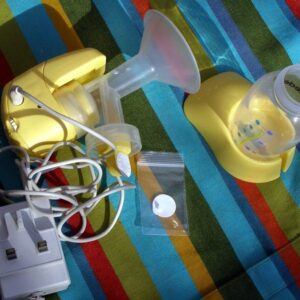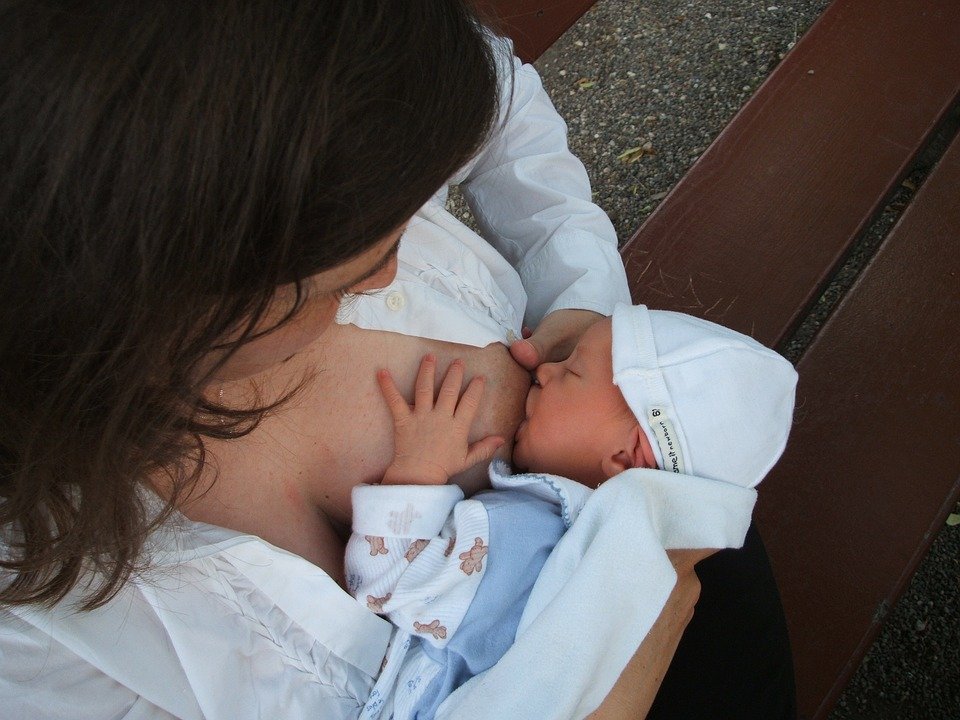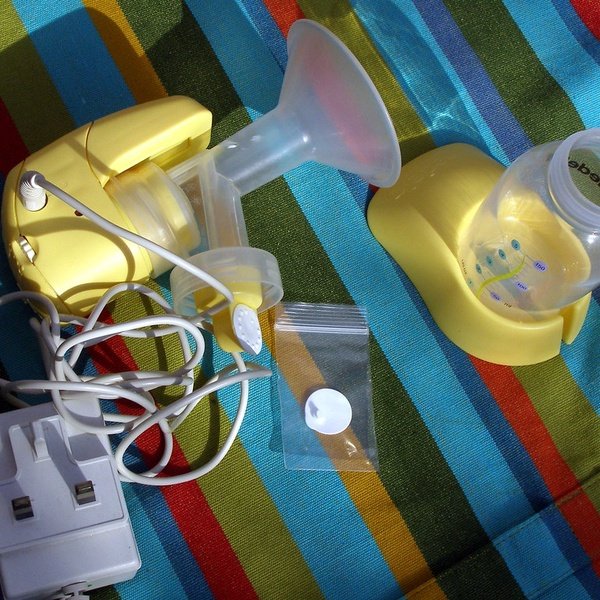Breastfeeding can feel like an Olympic sport at times, especially if your baby takes in a good amount of breast milk. There are days that it feels like no matter what you do, you can’t keep up with the demand. Even when you are keeping up, you may feel as though your milk supply isn’t where it should be. This will have you looking for ways to increase milk supply. In your quest to make this happen, chances are you’ve come across “power pumping”. That definitely sounds like an Olympic event! But, could this be the answer? Does power pumping work? Let’s take a look.
What is Power Pumping?
Power pumping is a way to make your body think that it needs to produce more milk right away. It mimics cluster feeding, just using a breast pump instead of with your baby. When your baby cluster feeds he stays at the breast, nursing on and off to get milk. The idea with power pumping is to empty the breast through pumping so that it refills again quicker. This allows you to pump again sooner.
View in gallery
Power pumping tells your body to increase its milk production because you’re pumping more. This means more milk for your baby when he needs it and less stress for you because the milk is already there.
It’s important to recognize that power pumping is not for everyone. Power pumping should be reserved for women who truly have a low milk supply. If your milk supply is adequate, you shouldn’t try power pumping just to stock your freezer when you’re not around for a feeding.
Power pumping when it isn’t necessary can cause oversupply issues. This can include feeling as though your breasts are hard or full all of the time. You can also tell if you have an oversupply issue if your breast sprays milk right after your baby unlatches.
It’s also not advised to start power pumping if your baby cluster feeds and you can accommodate those feedings. This should naturally increase your milk supply because it works on supply and demand.
Why Do Women Power Pump Instead of Nurse More?
Some people may say that if your baby wants more milk, just nurse more. While some women can increase their milk supply by nursing their baby on demand, that’s not always possible for everyone. With the demands of work and everything else in our lives, it’s sometimes easier to pump, especially if your baby is at daycare.
View in gallery
For other moms, nursing is difficult if the baby doesn’t always latch properly or if the baby can’t settle down. These moms will try power pumping if they still want their babies to have the nourishment of breastmilk.
How Can I Start Power Pumping?
Before you start becoming BFFs with your breast pump, talk to a lactation consultant to see if you really do have a low milk supply. What you perceive as low may actually be normal.
But, if the consultant agrees and you check all the boxes of a good power pumping candidate, it’s time to get started. Remember, everyone is going to find a schedule that works best for them, but here are some pointers if you want to increase milk supply.
Have the Right Equipment
You obviously need a breast pump. A double electric breast pump is recommended for power pumping. We recommend the Bellababy Double Electric Pump. A single pump can still get the job done, but it’s going to take longer. Plus, you don’t get the stimulation going for good milk supply as you do with the double electric breast pump.Make sure your breast pump is working properly. If your pump is older than one year and you use it frequently, think about replacing it. In the very least, replace some of the parts like the valves or tubes every 3-6 months. This will keep the milk flowing properly and prevent you from thinking you have a low milk supply when that’s not the case. Some women think they’re not producing enough milk when, in fact, their pump isn’t working properly.

Make Sure You Have the Time
Power pumping is a process. To do it the right way, you have to set aside time. To start, try to block off one hour. No, you’re not going to be pumping for the entire time. There are rest breaks built into the process. Knowing that you have one hour reserved can help you relax and get the most out of it.
Set a Power Pumping Schedule
If you’re new to power pumping, this may be a good schedule to start with:
- 20 minutes of pumping
- 10-minute break
- 10 minutes of pumping
- 10-minute break
- 10 minutes of pumping
Start with one hour a day. See how it goes and how you feel. If you have the time, you can do another hour for a maximum of two hours a day.
If your schedule doesn’t allow for a full hour or your body can’t handle it, you can try this shortened schedule:
- Pump 5 minutes
- Rest 5 minutes
- Pump 5 minutes
- Rest 5 minutes
- Pump 5 minutes
- Rest 5 minutes
It will be a case of trial and error to see which schedule you can accommodate and which one works best for you.
Throughout the rest of the day, pump the normal amount of time you normally would. Ideally, you should replicate your baby’s feeding schedule. If your baby eats every three hours, try pumping for 15 minutes every 3 hours.
What is the Best Time of Day to Power Pump?
Power pumping should be done when it is convenient for you. If you have some flexibility in your schedule, try to do it first thing in the morning. Research has shown that milk volume is typically at its greatest in the morning. If possible, try it before your baby wakes up. This way there will be no interruptions.
View in gallery
If you’re just starting out with power pumping, try on the weekend, especially if there is another adult in the house. This way they can focus on taking care of the baby and you can focus on pumping. Plus, you won’t be stressed trying to get ready for work and trying to get the baby ready for daycare, if that’s the case. You can simply focus on how to increase milk supply without interruption.
How Much Milk Will Power Pumping Produce?
Many women don’t know if they’re power pumping correctly because they’re unsure if they’re making enough milk. As we’ve been saying, everyone’s body is different. Typically, a woman who is breastfeeding all the time should be able to produce anywhere from ½ ounce to 2 ounces per session for both breasts. Keep track of how much milk you’re producing and see if you’re in that range. If not, ask a lactation consultant if the amount you are producing is adequate.
What Can I do to Make Power Pumping More Relaxing?
Let’s face it, the idea of sitting down with your breast pump for about an hour isn’t the most appealing. But, there are things you can do to make it a relaxing and enjoyable experience.
Make it a Cozy Spot
Make sure the area you’re sitting in for your power pumping session is comfortable. This means finding a comfy chair, making sure the temperature is good, and maybe even playing soothing music.
The more relaxed you feel, the better the results. If you’re sweating or shivering cold, your body won’t be able to relax and you won’t get optimal results.
Drink Plenty of Water
Keeping hydrated with water is one of the best things you can do to increase your milk supply. Since you’re in for a marathon pumping session, keep a bottle (or two) of water handy. This will not only keep you hydrated but will also help to keep you alert. When you’re dehydrated, your body feels drained and you can’t function properly…that includes being able to produce milk properly.
Keep a Photo of Your Baby Nearby
Studies have shown that looking at photos of your baby can help to release oxytocin. This hormone can help in milk production.
Following these tips can help. Also, don’t forget to give your body time to let the process work. The more pressure and stress you put on yourself to make it work, the longer it will take to increase milk supply.
How Quickly Will I See Results?
You’re likely not going to be able to pack your freezer with milk after one day of power pumping. Some women have seen an increase in three days, while others need to pump for a week. Every woman’s body is different. Don’t be discouraged if it takes a while for your body to respond.
Do I Have to Power Pump Until I’m Done Breastfeeding for Good?
No! Power pumping is used to increase milk supply. Once you see your supply increase, you can stop. Some women start up again if they see another drop. See what works best for you and your situation.
I Tried Power Pumping, It Didn’t Work, Now What?
If you’ve tried power pumping several times and it’s just not working to boost milk supply, don’t freak out! You’re still a super momma and you got this! There are several other things you can try that may also work.
View in gallery
-
- Try nursing more frequently. This is one of those things that may not be possible for everyone, depending on your schedule. But, if you can, nurse more often and see if that boosts your milk supply.
- Massage your breasts to increase milk stimulation.
-
- Drink more water and fewer fluids that dehydrate you. Caffeine is known to dehydrate the body. Lay off the caffeinated beverages if you’re looking to increase milk supply. Also, check with your doctor about how much caffeine should be in your diet when you’re breastfeedings. Remember, whatever you eat and drink can get passed down to the baby.
- Eat foods that are rich in protein.
As always, talk to your doctor or a lactation consultant if you feel you’ve tried everything but are still not getting an adequate milk supply. They may suggest a supplement or other changes to your diet.
Power Pumping: The Bottom Line
Here are a few of the big takeaways about power pumping:
- It is only for women who have a low milk supply. This should be confirmed by a lactation consultant. Getting on a power pumping schedule when you don’t need to be can cause unnecessary problems.
- Find a schedule that works for you and don’t compare your results to other people’s. Your body is unique. It will produce what it can, not what the other moms can.
- Get your pump checked out to make sure it is working properly. You don’t want to assume you have low milk supply when it’s your pump that’s at fault.
- The best time to pump is in the morning when milk supply is at a high volume.
- You don’t have to power pump forever, just until your supply is at a better level.
- The more relaxed you are, the more successful you’ll be at power pumping.
- If power pumping is not working, there are other things you can do to increase milk supply, such as drinking more water and trying to nurse more often.
Remember, producing milk for your baby is tough work. Don’t be too hard on yourself! Feel confident that you are doing the best you can to nourish your baby.
If you ever feel as though your baby is not getting enough nourishment, talk to the pediatrician. They’ll be able to tell you whether this is the case. In the meantime, keep calm and power pump on!










